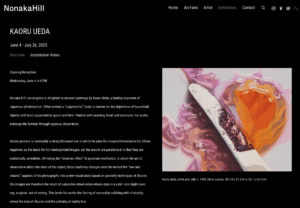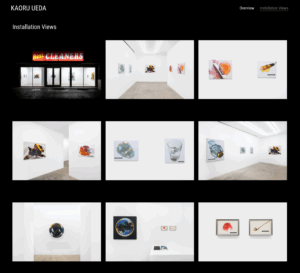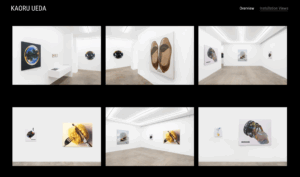KAORU UEDA Exhibitions at Nonaka-Hill in Los Angeles

アメリカ ロサンゼルスのNonaka-Hillで、個展を開催しています。
2025年6月4日~7月26日
ご近所の方がいらっしゃれば、ご訪問ください。
→ KAORU UEDA Exhibitions at Nonaka-Hill

→ Address : 720 N. Highland Avenue, Los Angeles, CA 90038
Nonaka-Hill Los Angeles is delighted to present paintings by Kaoru Ueda, a leading exponent of Japanese photorealism. Often termed a “superrealist,” Ueda is renown for his depictions of household objects and food suspended in space and time. Painted with exacting detail and concision, his works estrange the familiar through rigorous observation.
ロサンゼルスのノナカ・ヒルでは、日本のフォトリアリズムを代表する上田薫の絵画展を開催できることを大変嬉しく思います。しばしば「スーパリアリスト」と称される上田は、家庭用品や食品を空間と時間の中に浮かせたような描写で知られています。緻密かつ簡潔な筆致で描かれた彼の作品は、徹底的な観察によって、見慣れたものを非日常的な存在へと変容させます。
Ueda’s process is ostensibly a straightforward one in which he uses the visual information in his 35mm negatives as the basis for his hand-painted images; yet the results are paradoxical in that they are realistically unrealistic. Mirroring the “observer effect” in quantum mechanics, in which the act of observation alters the state of the object, Ueda intuitively changes what he termed the “raw and chaotic” aspects of his photographs into a new visual state based on painterly techniques of illusion. His images are therefore the result of subjective observation whose style is a cold—one might even say, surgical—act of seeing. This lends his works the feeling of sensuality colliding with clinicality, where the eros of illusion and the sobriety of reality blur.
上田の制作プロセスは一見するとシンプルで、35mmフィルムのネガに写った視覚情報をもとに手描きで絵を描いています。しかしその成果は、リアルでありながら非現実的という逆説的なものです。量子力学における「観測者効果」――観察するという行為自体が対象の状態を変えてしまうという原理に通じるように、上田は写真の「生々しく混沌とした」側面を直観的に変容させ、絵画ならではの錯覚技法を通じて新たな視覚表現へと昇華させています。こうして彼のイメージは、主観的な観察の産物でありながら、そのスタイルは冷静で、ある意味では外科的な視線とも言える描写をもっています。このことが、彼の作品に官能性と分析的冷静さが交差するような印象を与えているのです。幻想のエロスと現実の禁欲性が溶け合う場所、それが彼の絵画です。
Partly for this reason, there is a pop art sensibility subtly embedded within Ueda’s paintings. This is partly due to the estrangement of familiar objects through the marriage of photography and painting; but it’s also due to Ueda’s nod to Jasper Johns’ use of letterforms. In his paintings of soap bubbles and bottles, he renders his name in tromp l’oeil as an embossed label. Also akin to pop, Ueda tends to dispense with receding space, focusing instead on the object’s physical phenomena. As we enter its micro worlds of reflections and color shifts, Ueda gives it an iconic and spiritual dimension devoid of irony. Ueda is an artist more endeared to the power of subjective observation than to the politics of commodification.
こうした理由の一つとして、上田の絵画にはポップアート的な感性も内包されていると言えるでしょう。それは、写真と絵画の融合によって見慣れた物体が異化されていることに加え、ジャスパー・ジョーンズが文字を絵画に取り込んだことへのオマージュにも見られます。石鹸の泡や瓶を描いた作品では、自身の名前をエンボス加工のように描き、トロンプ・ルイユ(だまし絵)の技法で表現しています。またポップアート同様、遠近感を排し、物体の物理的な現象に焦点を当てているのも特徴です。その反射や色彩の移ろいのミクロな世界に私たちを誘いながら、上田はそれらにアイコニックで精神的な次元を与えています。皮肉ではなく、あくまで主観的観察の力への愛着から生まれる表現です。
Aspects of Ueda’s work can be surely traced to his biography: born in Tokyo in 1928, he initially sought a degree in medicine when he came of age but switched to pursuing painting at Tokyo University of the Arts. He eventually had his first solo exhibition in Tokyo in 1958, at which time he had been working as a graphic designer to support himself. In 1956, he had won the grand prize in an international poster competition funded by MGM studios. His graphic design studio consequently grew to a sizable staff and his painting practice became waylaid for a decade. When he restarted his painting practice in earnest, his use of photography took hold, imbibing aspects of mass culture absent from his early work.
上田の作品には、彼の人生の経歴が色濃く反映されています。1928年、東京・代々木に生まれた彼は、若い頃は医学を志していましたが、後に東京藝術大学で絵画を学ぶことを決意しました。1958年には東京で初の個展を開催。この頃は生計を立てるためにグラフィックデザイナーとしても活動していました。1956年、MGMスタジオ主催の国際ポスターコンペティションでグランプリを受賞。その後、彼のデザインスタジオは大きく成長し、10年間ほど絵画制作から遠ざかります。再び本格的に絵画に取り組むようになってからは、写真を取り入れるようになり、初期には見られなかった大衆文化の要素が作品に表れ始めました。
As a consequence, Ueda’s paintings have an element of seduction that underwrites most popular advertising. But what his paintings are seducing us into is not the consumption of the object, but the physical wonderment of it. Ueda takes great pleasure in contrasting the densities, surface textures, and colors of his objects, as in his paintings of cutlery and Jell-O, sponges, or jam. We also find this in his soap bubbles and bottles, whose surfaces are stages for light and shadow through which we find another reality. Case in point: in Soapbubble M, 1982, we see the artist with his camera in the reflection, alluding to the handmade process of building an illusion, such as in The Arnolfini Marriage, 1434, by Jan Van Eyck. In it, we see the artist’s reflection in a convex mirror (a soap bubble!) behind the marital pair. In this sense, Ueda nods to a tradition that long preoccupied artists before modernism, in which the painter highlighted his subjective experience as the ur-subject of the painting. Ueda’s paintings, therefore, are documents of how an object can be changed by the artist’s observation, reminding us of how our perceptions make and remake the world with every moment of contact.
その結果として、上田の作品には、多くの広告がもつ「誘惑性」が含まれています。しかし、彼の絵画が誘っているのは、モノの消費ではなく、その物理的な驚きや美しさです。スプーンやゼリー、スポンジやジャムといった対象物の密度、表面の質感、色彩の対比を描くことに、上田は大きな喜びを感じています。また、石鹸の泡や瓶などの表面には、光と影の舞台としての側面があり、そのなかに別の現実が垣間見えます。たとえば1982年の《Soapbubble M》では、泡の反射の中にカメラを構えた作者自身が映っており、手作業によって錯覚を構築するという行為に言及しています。これはヤン・ファン・エイクの《アルノルフィーニ夫妻の肖像》(1434年)で、夫妻の後ろの凸面鏡に画家自身が映り込んでいる構図を思い起こさせます。上田は、モダニズム以前に画家たちがこだわっていた「主観的体験を描く」という伝統にさりげなく敬意を示しているのです。
つまり、上田の絵画は、対象がどのようにして作家の観察によって変容していくか、その記録であり、私たち自身の知覚がどのように世界をつくり、再構築しているかを思い出させてくれるのです。
––
Kaoru Ueda was born in 1928 in Yoyogi, Tokyo. Selected solo and group exhibitions include Tokyo Metropolitan Art Museum (2024); Takamatsu City Museum of Art (2023); Hokkaido Museum of Modern Art (2023); Ibaraki Museum of Modern Art (2021); Yokosuka Museum of Art | Saitama Prefectural Museum of Modern Art (2020); Okazaki Children’s Museum of Art (2020); Kanagawa Prefectural Museum of Modern Art, Hayama (2017); Mito City Museum (2014); Sagamihara Civic Gallery (2003); Nerima Art Museum (2001); Rias Ark Museum of Art | Miyagi Prefecture (2001); Sakamoto Zenzo Museum of Art / Kumamoto (1999); Toyota Municipal Museum of Art (1998); Egyptian International Print Triennial, Cairo (1997); Kyoto Municipal Museum of Art (1997); Gwangju Museum of Art (1995); Museum of Modern Art, Shiga (1994); Tokyo Metropolitan Art Museum (1993); Shizuoka Prefectural Museum of Art (1990); Hiroshima City Museum of Contemporary Art (1989); Kasama Nichido Museum of Art/Ibaraki (1988); Saitama Prefectural Museum of Modern Art (1985); The Museum of Modern Art, Saitama (1983); Korea Arts and Culture Promotion Institute Art Hall, Seoul (1981); Tokyo Metropolitan Art Museum (1978); Tokyo Metropolitan Art Museum/Kyoto Municipal Museum of Art (1976); Seibu Museum of Art (1975); Dusseldorf Art Museum (1974); Tokyo Metropolitan Art Museum (1974). Kaoru Ueda was a professor at Ibaraki University from 1985 to 1993.
Museum and public collections: National Museum of Modern Art, Mexico City, Mexico; National Museum of Modern Art, Tokyo, Japan; Tokyo Metropolitan Art Museum, Tokyo, Japan; Queensland Art Gallery, Brisbane, Australia
上田薫(Kaoru Ueda)は、1928年東京都代々木に生まれました。
個展およびグループ展の主な開催歴:
東京都美術館(2024年)
高松市美術館(2023年)
北海道立近代美術館(2023年)
茨城県近代美術館(2021年)
横須賀美術館・埼玉県立近代美術館(2020年)
岡崎市美術博物館(2020年)
神奈川県立近代美術館 葉山(2017年)
水戸市立博物館(2014年)
相模原市民ギャラリー(2003年)
練馬区立美術館(2001年)
リアス・アーク美術館(2001年)
坂本善三美術館(1999年)
豊田市美術館(1998年)
カイロ国際版画トリエンナーレ(1997年)
京都市美術館(1997年)
光州美術館(1995年)
滋賀県立近代美術館(1994年)
東京都美術館(1993年)
静岡県立美術館(1990年)
広島市現代美術館(1989年)
笠間日動美術館(1988年)
埼玉県立近代美術館(1985年、1983年)
韓国ソウル 芸術文化振興院(1981年)
東京都美術館(1978年、1976年、1974年)
京都市美術館(1976年)
セゾン美術館(1975年)
デュッセルドルフ美術館(1974年)
教育歴:
1985年から1993年まで茨城大学教授を務める。
作品収蔵先(公共・美術館コレクション)
メキシコ国立近代美術館(メキシコシティ)
東京国立近代美術館(日本)
東京都美術館(日本)
クイーンズランド・アートギャラリー(ブリスベン、オーストラリア)

